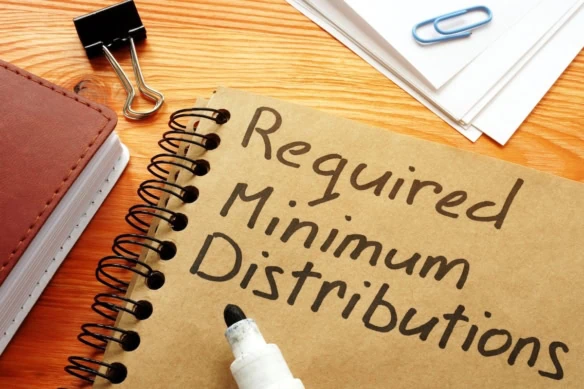When you reach a certain age, you’ll likely be required to withdraw a certain percentage of your savings from your retirement account each year. However, these required minimum distributions (RMDs) vary from year to year, which means you’ll have to re-calculate your RMD each year.
We frequently receive emails asking about what the RMDs would be for certain levels of savings—and a level we see all the time is $500,000.
If you happen to be in the same boat, or your savings are in that general ballpark and you’d like to get a rough read on how much you’d have to withdraw each year, read on.
Let’s look at what your RMDs might be if you have $500,000 tucked away in your retirement accounts. I’ll also provide some basic information about required minimum distributions, show you how to do the calculations yourself, and briefly discuss options for reducing your RMDs.
Disclaimer: This article does not constitute individualized financial advice. The information appears for your consideration, not as a personalized recommendation. Act at your own discretion.
How Do Required Minimum Distributions Work?

Once you reach a certain age (typically 73), a wide variety of tax-deferred retirement accounts—401(k)s, 403(b)s, individual retirement accounts (IRAs), and more—require you to begin withdrawing a portion of your savings each year.
These are called required minimum distributions, or RMDs.
Take, for example, traditional IRAs and their many variants (SEP IRAs, SIMPLE IRAs, etc.). When you turn 73, you have until April 1 of the following year to take your required distributions. For every year after that, your RMDs are due by the end of the year.
Participants in tax-deferred workplace retirement plans, such as a traditional 401(k), have similar rules, but they can usually delay RMDs until they retire (unless they’re a 5% owner of the business sponsoring the plan). Tax-exempt Roth retirement accounts aren’t subject to RMDs, however.
A few other important things to know:
- You calculate your required minimum distribution amount each year using a formula (described in the next section) that factors in your previous year’s account balance.
- RMDs for traditional IRAs can be calculated across all of your IRAs, but you can pay the total from all, some, or even just one of your IRAs.
- RMDs for workplace accounts generally must be calculated for each individual account, though 403(b)s are an exception and can be calculated and paid like IRAs.
- If you take more than the minimum in one year, you can’t apply the excess to your RMD for a later year.
Lastly, failure to withdraw the full RMD by the due date can result in the amount not withdrawn being subject to a 25% excise tax—though the tax can be reduced or eliminated depending on your circumstances.
Do you want to get serious about saving and planning for retirement? Sign up for Retire With Riley, Young and the Invested’s free retirement planning newsletter.
How Do I Calculate My RMDs?

To calculate your RMD, do the following:
- Find the balance of your tax-deferred retirement accounts as of Dec. 31 of the prior years.
- Find your distribution period for the age you’ll turn in the current year. The IRS provides this information. You’ll use one of two tables:
- The Uniform Lifetime Table (Table III): Use if you are unmarried, married to a spouse who is no more than 10 years younger than you, or married to a spouse who is not the sole beneficiary of your account.
- The Joint and Last Survivor Life Expectancy Table (Table II): Use if you are married to a spouse who is both at least 10 years younger than you and listed as the 100% primary beneficiary of your account for the entire year.
- Divide each account balance by the distribution period to find each account’s RMD.
Example 1: John, who is unmarried, turns 77 in October 2027. He owns a traditional IRA worth $400,000 on Dec. 31 of the prior year (2026). To calculate his RMD, which is due by Dec. 31, 2027, he would divide his balance ($400,000) by the distribution factor (22.9) on Table III. His RMD for that IRA is $17,467.25 ($400,000 / 22.9 = $17,467.25).
A retirement plan administrator or IRA custodian might calculate the RMD, but the account owner is ultimately responsible for withdrawing the correct amount.
(Note: Additional general guidance on calculations, taxes, ways to reduce your RMDs and more can be found in our primer on how RMDs work.)
How Much Is My RMD If I Have $500,000 in My Retirement Accounts [Uniform Lifetime Table III]?

Now, we’ll help you figure out your RMDs if you have $500,000 saved up in your retirement accounts.
Importantly, any calculations assume that you have $500,000 in your account as of the end of the prior year, and that one of the following is true:
- All $500,000 is invested in one account of any kind.
- All $500,000 is invested across more than one IRA.
- All $500,000 is invested across more than one 403(b).
In most other situations (say, the $500,000 is split between a 401(k) and an IRA), you would need to calculate separate RMDs for each account based on their balance.
Let’s start with people who fall within the most commonly used table: Table III. Again, this is the table to use if you are unmarried, your spouse is not the sole beneficiary, or your spouse is not more than 10 years younger than you. The following is a sample of ages and distribution period for Table III:
- Age 73 has a distribution factor of 26.5.
- Age 74 has a distribution factor of 25.5.
- Age 75 has a distribution factor of 24.6.
- Age 76 has a distribution factor of 23.7.
- Age 77 has a distribution factor of 22.9.
- Age 78 has a distribution factor of 22.0.
- Age 79 has a distribution factor of 21.1.
- Age 80 has a distribution factor of 20.2.
Based on those distribution factors, if you had $500,000 in your retirement accounts at the end of last year, the following would be your RMD, rounded to the nearest dollar:
- Age 73: $18,868
- Age 74: $19,608
- Age 75: $20,325
- Age 76: $21,097
- Age 77: $21,834
- Age 78: $22,727
- Age 79: $23,697
- Age 80: $24,752
Related: When Should You Take Social Security?
How Much Is My RMD If I Have $500,000 in My Retirement Accounts [Joint + Last Survivor Table II]?

If you’re married, your spouse is more than 10 years younger than you, and your spouse is the sole beneficiary of your account, you’ll be using Table II, and thus your calculations will look different.
Unlike Table III, in which you only need your age to determine your life expectancy factor, Table II requires both your age and your spouse’s age.
Here’s a sample:
- Age 73, with a spousal age of 60, has a life expectancy factor of 28.6.
- Age 74, with a spousal age of 61, has a life expectancy factor of 27.7.
- Age 75, with a spousal age of 62, has a life expectancy factor of 26.8.
- Age 76, with a spousal age of 63, has a life expectancy factor of 25.9.
- Age 77, with a spousal age of 64, has a life expectancy factor of 25.0.
- Age 78, with a spousal age of 65, has a life expectancy factor of 24.1.
- Age 79, with a spousal age of 66, has a life expectancy factor of 23.2.
- Age 80, with a spousal age of 67, has a life expectancy factor of 22.3.
Based on those life expectancy factors, and $500,000 in retirement accounts as of the end of last year, the following would be your RMDs based on those ages, rounded to the nearest dollar:
- Age 73: $17,483
- Age 74: $18,051
- Age 75: $18,657
- Age 76: $19,305
- Age 77: $20,000
- Age 78: $20,747
- Age 79: $21,552
- Age 80: $22,421
Can I Reduce My RMDs?

Yes, there are several strategies that can reduce your RMDs. Some of the methods would have needed to be done prior to retirement, but if you didn’t take action earlier, don’t despair—you still have options.
Do you donate to charity every year or have been intending to? Individuals age 70½ and older can make qualified charitable distributions (QCDs) directly from an IRA to a qualifying charity. This lets you omit the charitable amount (up to annual limits) from your gross income. Once you reach RMD age, QCDs can count toward your distributions for the year.
Another option is to do a Roth conversion, as Roth accounts aren’t subject to RMDs. For people with incomes too high to qualify for a Roth conversion, you might still be able to do a backdoor Roth conversion. Just understand Roth conversions have tax implications, so don’t jump into this solution before weighing the pros and cons.
Want to talk more about your financial goals or concerns? Our services include comprehensive financial planning, investment management, estate planning, taxes, and more! Schedule a call with Riley to discuss what you need, and what we can do for you.









